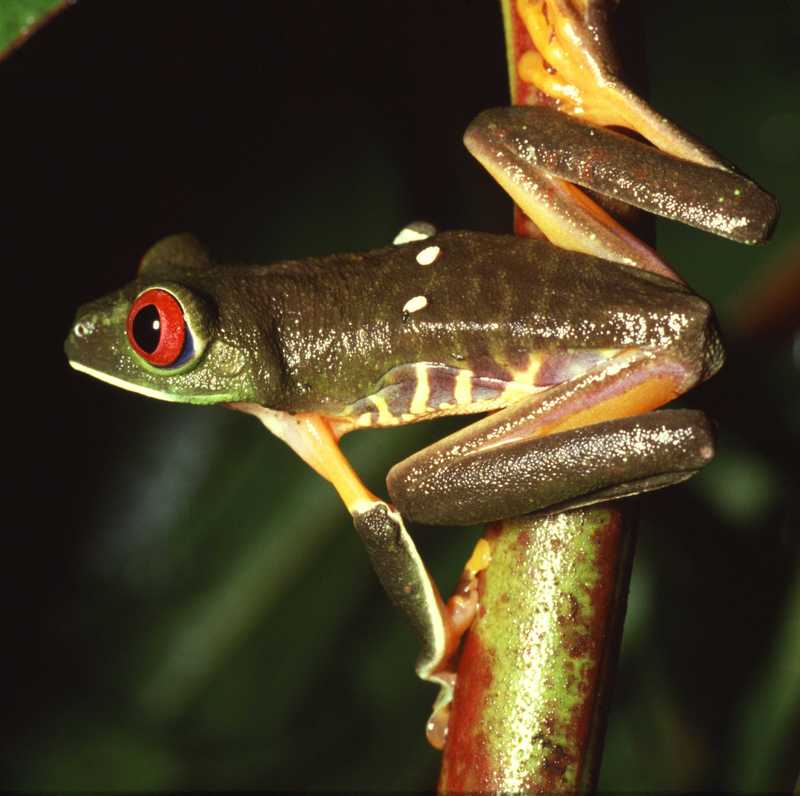Red-eyed Treefrog (Agalychnis callidryas) - wiki Agalychnis callidryas
From Wikipedia, the free encyclopedia
[Photo] Agalychnis callidryas ♀ (red-eyed treefrog) at Barro Colorado Island, Panama (1999). Photographer: Christian R. Linder
The Red-eyed Tree Frog (Agalychnis callidryas) is an arboreal hylid native to Neotropical rainforests.
Description
The Red-eyed Tree Frog is a medium-sized tree frog, reaching lengths of 50-75 millimeters. Its dorsal surface is green of varying shades, and its ventral surface is white. The sides of the frog are purple or blue, with vertical white stripes and orange toes. The males typically reach lengths of two inches, while the slightly larger females can reach three to five inches. Both have bulging red eyes with vertically narrowed pupils resemble the eyes of domestic cats. Red-eyed tree frogs have soft, fragile skin on their belly, and the skin on their back is thicker and rougher.
Bright markings along the sides and limbs reduces predation, Most animals that prey on A. callidryas (some bats, snakes, and birds) often rely on their vision. When the frog moves to avoid the predator the bright colorations flash into view (hence their name, flash colors) they throw off the predator. This is achieved by leaving a ghost image in the visual field of where the frog was originally. This confuses the predator and gives the frog time to hide. These flash colors may also deceive predators by making the frog appear poisonous.
Red-eyed tree frogs are not poisonous and rely on camouflage to protect them. During the day, they remain motionless, cover their blue sides with their back legs, tuck their bright feet under their belly, and shut their red eyes. They thus appear almost completely green, and well hidden among the foliage.
Reproduction
Female Red-eyed tree frogs lay 30-50 pale eggs on the underside of leaves and do not provide any parental care. Red-eyed tree frogs only vocalize when participating in a mating process called the “chorus-line”,. Males start to chirp, attracting females. The males attempt to mount one of the females, sometimes more than three males at a time per female. Once one male has achieved an amplexus embrace, the female begins laying her eggs. The eggs they have a rubbery, gelatinous coating that protects them from predators. An egg may even roll away from a predator before it can tear through the outer coating.
In one or two weeks, the tadpoles hatch and wriggle until they drop off the leaf into a pool of water below, where they metamorphose into frogs. They undergo metamorphosis and develop color once they are a near-mature tadpole. Tadpoles may take 75-80 days to grow into a full-sized adult. During their tadpole stage, their colors can change like a chameleon's, in response to their environmental conditions or their emotional state. Even slight temperature variations may cause underweight development.
Red-eyed tree frogs live about three to five years, in the wild.
Diet and behavior
Their most highly developed sense is sight, and they have parabolic vision. They can also pull down their eyes through the roof of their mouth to help push down food. They also rely on their tactile sense. They have well-developed grasping pads on each toe enabling climbing in vegetation. They are also, in a twist of evolution, skilled at singing.
Red-eyed tree frogs are carnivores, searching at night for their prey which includes moths, crickets, beetles, flies, and sometimes on smaller frogs. Natural enemies of the frog include birds, turtles, lizards, snakes, and bats and other mammals.
Threats
Deforestation continues to destroy red-eyed tree frog habitat throughout its range, and their numbers are decreasing. They are also captured for zoos and the pet trade.
Taxonomy
Red-eyed tree frogs are closely related to chorus frogs, which have the same body style and many of the same habits, though chorus frogs are more vocal.
Distribution and Habitat
Red-eyed tree frogs inhabit lowland rainforests from southern Mexico, through Central America, to Northern Colombia. They are often found near rivers or ponds.
http://en.wikipedia.org/wiki/Agalychnis_callidryas
| The text in this page is based on the copyrighted Wikipedia article shown in above URL. It is used under the GNU Free Documentation License. You may redistribute it, verbatim or modified, providing that you comply with the terms of the GFDL. |
